Diodes
What Is a Diode?
A diode is a semiconductor device, allowing the flow of current in one direction. If you compare the electric current to the flow of water, the diode is the image of a “valve”.
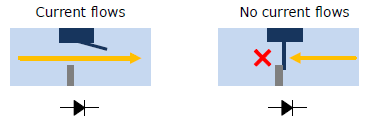
The following figure shows an example of an actual diode. The diode is marked on the cathode side. See Diode Structure for cathode.
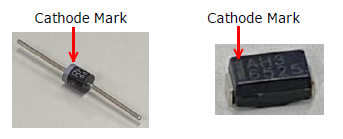
Diode Applications
Rectification
Diodes allow the current to pass in one direction only. This is called rectification. The following figure shows a full-wave rectifier circuit that uses the diode rectification. Full-wave rectifier circuits are often used in power supply circuits, and are combined with capacitors to convert alternating current to direct current.
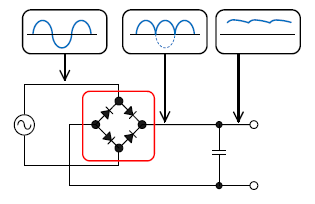
Reverse direction current prevenction
Diodes protect circuits and circuit components by preventing current from flowing in the reverse direction.
Overvoltage protection
Diodes protect circuits and circuit components from overvoltage.Diode Structure
Diode junction structures are classified into PN junctions and Schottky junctions.
PN junctions
Semiconductors whose charge carriers are holes are called P-type semiconductors. Semiconductors whose charge carriers are electrons are called N-type semiconductors. A structure in which a P-type semiconductor and an N-type semiconductor are joined is called a PN junction. Rebonding (carriers disappearing when electrons fill holes) occurs at the junction, creating a region no charge carriers are present. This is called the depletion layer.
The terminal on the P-type semiconductor side is called anode, and the terminal on the N-type semiconductor side is called cathode.
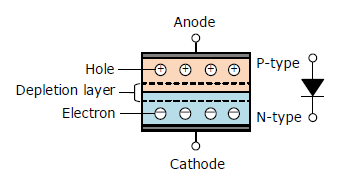
The N-layer of an actual diode consists of an N+ layer and an N− layer. The breakdown voltage of the diode is determined by the thickness of the N− layer and the carrier concentration. The thicker the N− layer and the lower the carrier concentration, the higher the breakdown voltage. However, there is a trade-off relationship between breakdown voltage and resistance, thus, increasing the breakdown voltage also increases the resistance.
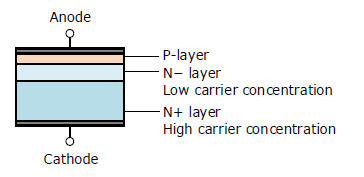
Schottky junction
A structure in which metal and a semiconductor (generally an N-type semiconductor) are joined is called Schottky junction. A Schottky barrier is created at the junction. The terminal on the metal side is called the anode, and the terminal on the N-type semiconductor side is called the cathode. Since P-type semiconductors are not used, holes are not used as carriers.
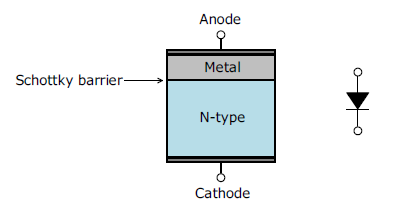
A diode allows the current to flow when a voltage is applied in the forward direction (positive voltage to the anode and negative voltage to the cathode). Even if voltage is applied in the reverse direction, no current flows.
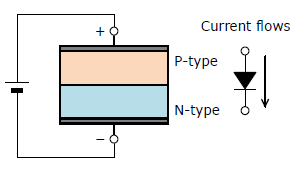
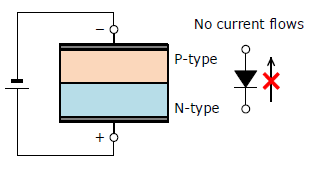
Why Does the Current Flow in One Direction?
The current flow is described using a PN junction diode as an example.
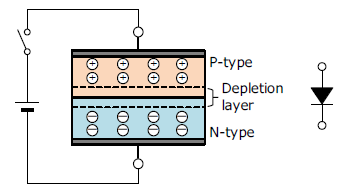 |
No voltage applied Holes and electrons are in equilibrium. |
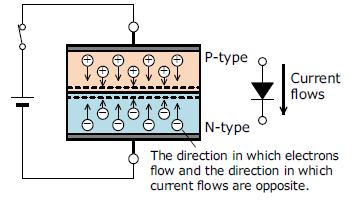 |
Voltage applied in the forward direction When a voltage is applied in the forward direction, the depletion layer narrows, and holes and electrons repeatedly recombine. Holes and electrons continue to move in the direction of the arrow (i.e., the current flows.) |
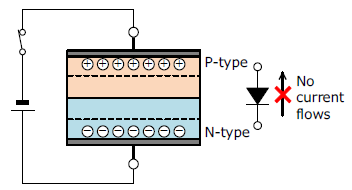 |
Voltage applied in the reverse direction When a voltage is applied in the reverse direction, the depletion layer expands, and holes and electrons do not move (i.e., no current flows.) |
Questions or Comments?
Please feel free to contact us if you cannot find the desired product from the lineup.
